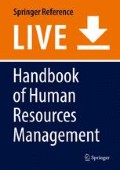Abstract
Combining reward and jobs and differentiating reward based on job complexity have been practiced by human beings for more than 4000 years. Since the time in Lagash, Iraq, when the oldest documents regarding reward and jobs were found, the way human beings and organizations have conducted the differentiation of jobs has changed significantly. The general principles of job evaluation were defined at a conference in the early 1950s in Geneva.
Nowadays, the analysis of organizations and jobs and the evaluation of jobs using a proven global methodology are well established in global organizations and have added real value to the further development of the organizations, especially when results and methodology are not only used for reward purposes but also in talent management or for the improvement of the organization.
For senior management positions, both job analysis and job evaluation are processes where organizational principles and facts are translated into the ranking and grading of senior management positions in a reproducible manner.
For all other jobs in an organization below senior management, more and more companies prefer the development and implementation of a global job catalog/job family structure to generate global transparency and to differentiate in a consistent manner, but every time a job evaluation methodology will be behind.
Yes, the results of the analysis, evaluation, and grading of jobs can be used to benchmark reward packages regarding internal consistency and external competitiveness, but there are other HR topics where deep knowledge generated through the overall processes can add real value.
References
Bowers J (2001) Valuing work: an integrated approach. In: The executive handbook on compensation: linking strategic rewards to business performance. The Free Press, New York, pp 178–193
Garonzik R, Nethersell G, Spreier S (2006) Navigating through the new leadership landscape. In: Leader to leader, Issue 39. Leader to Leader Institute, San Francisco, pp 30–39
Jensen D, McMullen T, Stark M (2007) The managers guide to rewards. American Management Association, New York
Nethersell G (2001) The role of job measurement and work assessment. In: The executive handbook on compensation: linking strategic rewards to business performance. The Free Press, New York, pp 138–149
Sperling R (2001) The Hay Group guide chart-profile method. In: The executive handbook on compensation: linking strategic rewards to business performance. The Free Press, New York, pp 793–828
Author information
Authors and Affiliations
Corresponding author
Editor information
Editors and Affiliations
Rights and permissions
Copyright information
© 2015 Springer-Verlag Berlin Heidelberg
About this entry
Cite this entry
Reiher, K. (2015). Compensation and Benefits: Job Evaluation. In: Zeuch, M. (eds) Handbook of Human Resources Management. Springer, Berlin, Heidelberg. https://doi.org/10.1007/978-3-642-40933-2_76-1
Download citation
DOI: https://doi.org/10.1007/978-3-642-40933-2_76-1
Received:
Accepted:
Published:
Publisher Name: Springer, Berlin, Heidelberg
Online ISBN: 978-3-642-40933-2
eBook Packages: Springer Reference Business and ManagementReference Module Humanities and Social SciencesReference Module Business, Economics and Social Sciences

